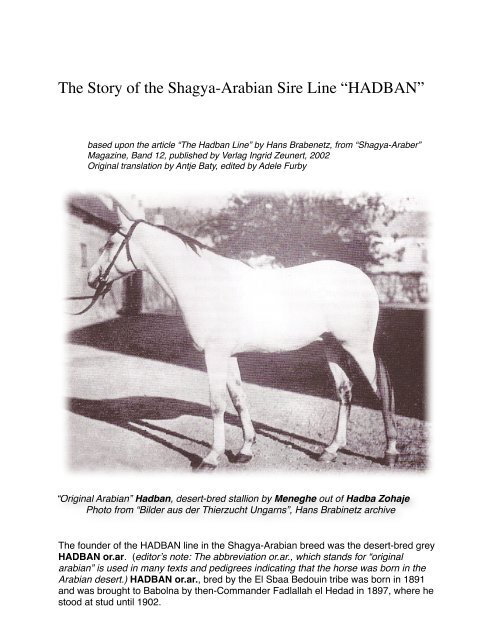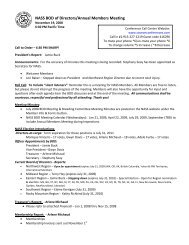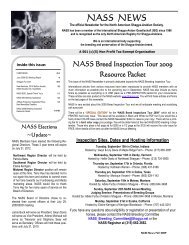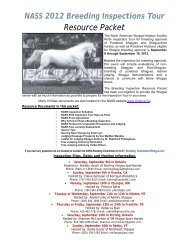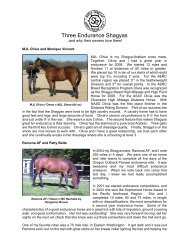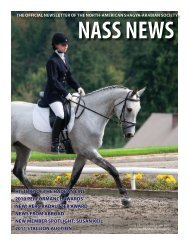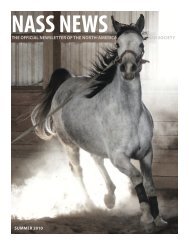Create successful ePaper yourself
Turn your PDF publications into a flip-book with our unique Google optimized e-Paper software.
<strong>The</strong> Story of the Shagya-Arabian Sire Line “HADBAN”<br />
based upon the article “<strong>The</strong> <strong>Hadban</strong> Line” by Hans Brabenetz, from “Shagya-Araber”<br />
Magazine, Band 12, published by Verlag Ingrid Zeunert, 2002<br />
Original translation by Antje Baty, edited by Adele Furby<br />
“Original Arabian” <strong>Hadban</strong>, desert-bred stallion by Meneghe out of Hadba Zohaje<br />
Photo from “Bilder aus der Thierzucht Ungarns”, Hans Brabinetz archive<br />
<strong>The</strong> founder of the HADBAN line in the Shagya-Arabian breed was the desert-bred grey<br />
HADBAN or.ar. (editorʼs note: <strong>The</strong> abbreviation or.ar., which stands for “original<br />
arabian” is used in many texts and pedigrees indicating that the horse was born in the<br />
Arabian desert.) HADBAN or.ar., bred by the El Sbaa Bedouin tribe was born in 1891<br />
and was brought to Babolna by then-Commander Fadlallah el Hedad in 1897, where he<br />
stood at stud until 1902.
<strong>Hadban</strong> I (<strong>Hadban</strong> or.ar. x 24 Gazlan), born at Babolna in 1899, was sold to<br />
German Southwest Africa (now Namibia), where he sired over 300 offspring.<br />
HADBANʼs son <strong>Hadban</strong> Iʼs quality was not immediately recognized due to the tendency<br />
of this line to mature late, and <strong>Hadban</strong> I was moved from Babolna to the Royal State<br />
Stallion Depot at Debrecen, and in 1910 he was sold and exported to Namibia in Africa.<br />
Another son of HADBAN, <strong>Hadban</strong> II, was born in 1903. His dam was a Gazlan I<br />
daughter, 52 Gazlan I, whose tail female line traces to the English Thoroughbred mare<br />
30 Maria xx. <strong>Hadban</strong> II stood at stud in Babolna from 1917 to 1920 and was moved to<br />
Debrecen in late 1920. While in Babolna in 1917, he sired a son out of 21 Hamdani<br />
Semri-2, who went to Romania in 1919, and eventually stood at the State Stud Farm at<br />
Radautz as <strong>Hadban</strong> III. (editorʼs note: According to Erika Schiele in her 1967 book, <strong>The</strong><br />
Arabian Horse in Europe, “...During the First World War the Babolna Stud was<br />
evacuated in the face of the Rumanian invasion of 1919, all except the mares that were<br />
heavy in foal or had just foaled. But the Rumanians took away all they could lay their<br />
hands on, comprising sixty-five brood mares, forty young stock, and thirty-eight weaned<br />
foals, as well as the twenty-six-year-old Siglavy Bagdady Sr.” ) This stallion, <strong>Hadban</strong> III ,<br />
stolen from Babolna by the Romanian Army, founded the HADBAN line in Romania,<br />
while the HADBAN sire line eventually disappeared in Hungary. <strong>Hadban</strong> IIIʼs 1907 son<br />
out of the Radautz-bred purebred Arabian mare 265 Amurath-11, became <strong>Hadban</strong> IV,<br />
who became, for all practical purposes the progenitor of all further “HADBANS”.
<strong>The</strong> HADBAN Sire Line Chart reproduced from “Shagya-Araber” Band 11<br />
A stallion performance testing 4,000 meter race in Radautz in 1936 shows a son of<br />
<strong>Hadban</strong> IV (out of 4 Dahoman XIX) winning in 4.56 minutes. Brabinetz archive
Several HADBAN-line stallions also were significant outside Romania. For example<br />
<strong>Hadban</strong> XIII, a brown stallion born in 1960 out of 70 Shagya XXX-5, was born in<br />
Mangalia. According to Professor Ottescu this <strong>Hadban</strong> XIII measured 15.2 and was a<br />
strong and fertile stallion <strong>with</strong> a small head <strong>with</strong> a straight profile, a significant neck,<br />
good <strong>with</strong>ers, and a strong back as well as a very broad and deep chest. One of his<br />
sons was the mighty white <strong>Hadban</strong> XIII-77, who stood at the Anglo-Arabian Stud Farm<br />
Jegalia, where he was known as “Halmieu”. Standing 16.1 hands, he was at the upper<br />
size limit for his breed. He was known as not only a good riding horse, but also as a<br />
very good carriage horse.<br />
<strong>The</strong> very best son of Halmeu<br />
was the white “Serpas”, who<br />
has proven himself to be a<br />
prepotent stallion in Jegalia. He<br />
was known as the best<br />
dressage horse of his day in<br />
Romania. <strong>Hadban</strong> XIII-77 and<br />
his paternal half-brother<br />
<strong>Hadban</strong> XIII-38 made a wellmatched<br />
driving pair. <strong>The</strong>ir<br />
powerful matching trots were<br />
only eclipsed by <strong>Hadban</strong> XXII,<br />
whom we shall mention later in<br />
this article.<br />
<strong>Hadban</strong>XXXIX, 1978, by <strong>Hadban</strong> XXII x 136 Mersuch V-7,<br />
known as “Nemo” in the Anglo-Arabian breed in Jegalia is<br />
another great example of the size and power of the Romanianbred<br />
Anglo-Arab carriage horses Erich Adensamer photo<br />
Another of <strong>Hadban</strong> XIIIʼs sons, the brown <strong>Hadban</strong> XX, out of 96 Koheilan XXI-9, also<br />
became chief stallion. <strong>Hadban</strong> XX was a well-respected stallion who became known<br />
particularly for producing fine daughters.<br />
<strong>Hadban</strong> XIIIʼs grey paternal half-brother <strong>Hadban</strong> XXII, out of 86 Koheilan XXI-5 from<br />
the mare family VII in Radautz, was born in 1964 and is the main progenitor of the<br />
HADBAN sire line in Romania today. He was a strong stallion measuring over 15.3,<br />
who, at his performance test on the infamously hard ground of the Baragan Steppe was<br />
the superior winner under the rider as well as in front of the carriage. As a carriage<br />
horse he was unsurpassed, so much so that it was difficult to find a suitable match for<br />
him. He also proved to be an exquisite riding horse, and was featured in several<br />
movies. <strong>The</strong>re was always a continuous quarrel amongst the actors and their doubles<br />
because they all wanted to ride only him! He had the bad luck to suffer a serious hoof<br />
injury and also was badly bitten by another stallion who accidentally got loose in the<br />
stable. He produced four approved sons in Jegalia which were used for both Shagya-<br />
Arabian and Anglo-Arabian breeding. Many of his daughters were exceptionally good<br />
performers, and some of these daughters were also used for Anglo-Arabian breeding.
Watercolor of <strong>Hadban</strong> XXII by Professor Konstantin Ottescu in Bucharest<br />
<strong>Hadban</strong> XXII and his descendants are known for their willingness and firmness of<br />
character which is so typical of the Shagya-bred horses.<br />
Yearling and two year old fillies at the infield of the racetrack at the Anglo-Arab Stud Jegalia<br />
1989 photo by Franz Lehner
<strong>Hadban</strong> XXVII, by <strong>Hadban</strong> XXII and out of 162 Mersuch-66 was during his lifetime<br />
already known as one of the best Shagya-Arabian stallions in Romania. This liver<br />
chestnut stallion <strong>with</strong> no white markings was born in the fall of 1980 in Brebeni.<br />
<strong>Hadban</strong> XXVII, 1980 (<strong>Hadban</strong> XXII x Mersuch V-66, from Mezohegyes mare family 270)<br />
1987 photo by Erich Adensamer<br />
Measuring 16 hands tall, <strong>with</strong> a 20.5 cm. cannon, he was noble and appealing despite<br />
his big size, and had a great “stallion expression”. He had a broad and deep body, wellformed<br />
prominent <strong>with</strong>ers, a good topline and a faultless foundation (i.e. legs). He was<br />
remarkable in appearance, <strong>with</strong> his sweeping, lightly springing trot. His rhythmic,<br />
ground-covering walk as well as his “flying” gallop fully answered the modern breeding<br />
aim. One could not overlook his exquisite character and his matching temperament.<br />
His strength and caliber are certainly traceable to the 10 members of the SHAGYA line<br />
going back to the 5th generation. He was used a great deal at stud in Brebeni, Slatina,<br />
and finally, in Radautz, and left behind mostly above-average descendants.<br />
Unfortunately, a strong colic put an end to his life way too early.<br />
His son <strong>Hadban</strong> XXXIII, born in Brebeni and out of 214 Shagya LI-28 (whose dam line<br />
is the Babolna line of 52 OʼBajan Siglavy, or.ar., 1848) stood at the State Stud of<br />
Mangalia for a short time before he was exported to Germany in 1994 for his new owner<br />
Sabine Koerber. He was presented in Aachen in 1997 and impressed <strong>with</strong> his nobility<br />
and his strong shoulders as well as his dynamic movements and outstanding character.<br />
His performance ability has been convincingly proven by his successful completion of<br />
sixteen 50-mile endurance rides.
Two views of <strong>Hadban</strong> XXXIII, Mangalia, who became <strong>Hadban</strong> XXVI-3 in Germany.<br />
On the left, at his German stallion licensing, and on the right, “at home” in Germany at<br />
the farm of his owner, Sabine Koerber<br />
Another son of <strong>Hadban</strong> XXVII, and quite obviously his best, is the dark brown<br />
Harapnik, who was imported in utero from Radautz to Germany by Gaby Conradty in<br />
1989. His dam Putna (born Koheilan XXIX-12) belongs to the Radautz mare family<br />
XXXVI/759 Moldauerin, and has proven herself to be a long-lived, useful and reliable<br />
using horse. (editorʼs note: Putnaʼs dam, 173 <strong>Hadban</strong> XIII, was by the previouslydescribed<br />
<strong>Hadban</strong> XIII, born in 1960 in Mangalia. <strong>Hadban</strong> XIII and Harapnikʼs<br />
paternal grandsire <strong>Hadban</strong> XXII were both sons of <strong>Hadban</strong> XI, thus consolidating the<br />
blood of <strong>Hadban</strong> XI in the pedigree of Harapnik.)<br />
Harapnik has very little purebred<br />
Arabian blood--in the 5th<br />
generation the only purebred<br />
Arabian is 19 Koheilan IV-17 from<br />
Babolna. Thus, Harapnik is a very<br />
welcome partner, even for mares<br />
<strong>with</strong> a high percentage of purebred<br />
Arabian blood. In 1993 Harapnik<br />
was on lease in lower Austria<br />
where, of his 8 foals, three sons<br />
were later approved as stallions<br />
and three mares became approved<br />
breeding mares. In Germany<br />
Harapnik passed the stallion<br />
performance test in Marbach <strong>with</strong><br />
107.61 points, placing fifth out of<br />
24. He had especially high notes<br />
for character, temperament,<br />
performance capacity, and rideability.<br />
Harapnik (<strong>Hadban</strong> XXVII x Koheilan XXIX-12)<br />
Ingrid Zeunert photo
Standing 16 hands tall, <strong>with</strong> a 19 cm. cannon, he is a classical type of Shagya-Arabian<br />
according to Austrian ideals, and fulfills the breeding aim for this breed. So far he has<br />
one approved son in Germany. A few of the <strong>photos</strong> of his offspring in Austria which<br />
accompany this article illustrate the worth of this above-average sire. In 1996 Harapnik<br />
stood at stud in Czech Republic as <strong>Hadban</strong> I CZ, where his offspring proved very<br />
satisfactory.<br />
Harapnik in Czech Republic. Due to the success of his Austrian-bred offspring, Austrian<br />
breeder Joseph Weiss leased Harapnik again in 2002. Peter Gorozdi photo. One of the mares<br />
bred was the Amos daughter Irahana-453, below, right, who was imported to the US in 2003<br />
and produced the colt foal *<strong>Hadban</strong> USA, below, left, who was approved for breeding in 2009.
Sons and Daughters of Harapnik<br />
Above, left, the approved stallion Santoz out of Sana by Zlatar, bred, owned, and photo by<br />
Josef Weiss, and, above, right, the approved stallion <strong>Hadban</strong>-151, out of Tobrok-26, bred,<br />
owned, and photo by Herbert Nitsch. Below left, the mare Turka-69, out of Tura, and below<br />
right, in front, Horodenka I, <strong>with</strong> her dam behind, Horaitza, bred and owned by Hans<br />
Brabinetz, both <strong>photos</strong> by Josef Weiss<br />
A paternal half-sister of Harapnik, the stately black <strong>Hadban</strong> XXVI-34, out of 326<br />
<strong>Hadban</strong> XXV-18, was born in Radautz in 1991. She went via the Hungarian stud farm<br />
Gyuerues into the possession of Peter Windrath of Italy. She belongs to the Radautz<br />
mare family XVIII, which was founded by “Stute 54”, born in 1820. In Italy she has had<br />
one colt and one filly, both of which are growthy and well-built and show great promise.<br />
In both cases the sire is Mersuch XIX-37, a noble black stallion born in Brebeni in 1987.<br />
With the stallion <strong>Hadban</strong> XVI, we will conclude our article about the HADBAN line. This<br />
stallion, born in Mangalia in 1955, out of 136 Shagya XXVI-1 (from the mare family of<br />
638 Moldauerin from the Bukowina Military Stud Farm, 1875) did not have offspring<br />
which futhered the sire line in Romania. His sire was <strong>Hadban</strong> VII, born in 1938 in<br />
Mangalia, who measured 15 hands <strong>with</strong> a 19.7 cm. cannon. <strong>Hadban</strong> XVI had a son<br />
born in Mangalia in 1969 who later came to Germany, where he was approved for<br />
breeding in 1973 and registered as <strong>Hadban</strong> XVI-8. He was a noble-appearing stallion,
ut <strong>with</strong> his height of only 14.3 1/2 hands, he was not very impressive. His dam<br />
belonged to the Radautz mare family of XLIX, J Harmonia, 1796 Lipizza.<br />
Unfortunately, in Volume I of the German Studbook for Shagya Arabians there are<br />
several faults in his pedigree as written.<br />
<strong>Hadban</strong> XVI-8, 1969 Mangalia by <strong>Hadban</strong> XVI, Mangalia and out of 328 Gazal VI-13,<br />
photographed at age 27.<br />
In April, 1992 <strong>Hadban</strong> XVI-8 produced the grey stallion Ramiro out of Resandra. His<br />
measurements of 15.3, <strong>with</strong> a 20 cm cannon, are probably due partly to having been<br />
raised <strong>with</strong> better nutrition than was available for his ancestors, as well as to a good<br />
knowledge of pedigrees by his breeder, along <strong>with</strong> some luck. On his damʼs side in the<br />
second, third and fourth row of ancestors are measurements of 15.3, 15.1, and 16<br />
hands. <strong>The</strong>se are members of the Radautz line of Shagya X. Experienced breeders<br />
know that size is not inherited from the parents alone. At the Marbach Stallion<br />
Performance Test <strong>Hadban</strong> XVI-8 had a score of 105.36 points. For temperament,<br />
character, willingness to perform, as well as jumping talent and scope he got 9 points.<br />
His breeder and owner is Irene Stassen. He has had numerous show successes<br />
including Reserve Championship in 1994 in Neustadt-Dosse and in 1999 in Stadl-<br />
Paura, as well as winning his class in 1996 in Babolna. In 1994 he was the winning<br />
stallion at the approval in Vechta, receiving gold. He is showing great talent in dressage<br />
and jumping under saddle and his foals are clearly taking after him, distinguishing<br />
themselves <strong>with</strong> good growth, caliber, correctness, nobleness, gaits, and character. His<br />
full sisters Hadba ll, 1989, Rissala, 1994, and Rahwina, 1995, are all of similar high<br />
quality.
“Blood Will Tell”--Evidence of In-depth Pedigree Study Resulting in Success:<br />
<strong>The</strong> Shagya-Arabian Stallion Ramiro, by <strong>Hadban</strong> XVI-8 and out of Resanda by<br />
Radautz, has been successfully shown up to “class M” in dressage<br />
(Editorʼs note: While judging the International Championship Show for Shagya-<br />
Arabians in Babolna in 1996 I was quite impressed <strong>with</strong> Ramiro, and even more so <strong>with</strong><br />
his full sister Hadba II. Of course I didnʼt know who they were, their pedigrees, or even<br />
that they were related while judging the show, but I remember clearly that Hadba II was<br />
the mare at that show that really stood out in my mind as a real RIDING horse, and I<br />
told her owner/breeder that when presenting her <strong>with</strong> her ribbon. I was quite amazed<br />
when studying the pedigrees afterwards to see that these two individuals were the<br />
offspring of a stallion <strong>with</strong> a rather “unimpressive” photo in the German Studbook--and I<br />
was quite impressed <strong>with</strong> the expertise of the breeder to have had the wisdom to<br />
choose to breed her Radautz daughter to <strong>Hadban</strong> XVI-8! )


